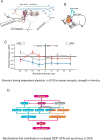Maladaptive plasticity in tinnitus--triggers, mechanisms and treatment
- PMID: 26868680
- PMCID: PMC4895692
- DOI: 10.1038/nrneurol.2016.12
Maladaptive plasticity in tinnitus--triggers, mechanisms and treatment
Abstract
Tinnitus is a phantom auditory sensation that reduces quality of life for millions of people worldwide, and for which there is no medical cure. Most cases of tinnitus are associated with hearing loss caused by ageing or noise exposure. Exposure to loud recreational sound is common among the young, and this group are at increasing risk of developing tinnitus. Head or neck injuries can also trigger the development of tinnitus, as altered somatosensory input can affect auditory pathways and lead to tinnitus or modulate its intensity. Emotional and attentional state could be involved in the development and maintenance of tinnitus via top-down mechanisms. Thus, military personnel in combat are particularly at risk owing to combined risk factors (hearing loss, somatosensory system disturbances and emotional stress). Animal model studies have identified tinnitus-associated neural changes that commence at the cochlear nucleus and extend to the auditory cortex and other brain regions. Maladaptive neural plasticity seems to underlie these changes: it results in increased spontaneous firing rates and synchrony among neurons in central auditory structures, possibly generating the phantom percept. This Review highlights the links between animal and human studies, and discusses several therapeutic approaches that have been developed to target the neuroplastic changes underlying tinnitus.
Conflict of interest statement
Berthold Langguth received honoraria for speaking and consultancy from ANM, Astra Zeneca, Autifony, Gerson Lehrman Group, Lundbeck, McKinsey, Merz, Magventure, Novartis, Neuromod Devices, Pfizer and Servier, grants and support for research from the Tinnitus Research Initiative, the German Forschungsgemeinschaft, the German Bundesministerium für Bildung und Forschung, the American Tinnitus Association, Astra Zeneca, Cerbomed, Deymed, Magventure, Sivantos and Otonomy, and travel and accommodation payments from the European Union (COST), Lilly, Servier and Pfizer.
Berthold Langguth holds patents for the use of neuronavigation for transcranial magnetic stimulation for tinnitus treatment and for the use of cyclobenzaprine for tinnitus treatment
Figures



Similar articles
-
Tinnitus: Maladaptive auditory-somatosensory plasticity.Hear Res. 2016 Apr;334:20-9. doi: 10.1016/j.heares.2015.06.005. Epub 2015 Jun 12. Hear Res. 2016. PMID: 26074307 Free PMC article. Review.
-
Noise exposure alters long-term neural firing rates and synchrony in primary auditory and rostral belt cortices following bimodal stimulation.Hear Res. 2017 Dec;356:1-15. doi: 10.1016/j.heares.2017.07.004. Epub 2017 Jul 13. Hear Res. 2017. PMID: 28724501
-
Directing neural plasticity to understand and treat tinnitus.Hear Res. 2013 Jan;295:58-66. doi: 10.1016/j.heares.2012.10.001. Epub 2012 Oct 23. Hear Res. 2013. PMID: 23099209 Review.
-
Auditory thalamic circuits and GABAA receptor function: Putative mechanisms in tinnitus pathology.Hear Res. 2017 Jun;349:197-207. doi: 10.1016/j.heares.2016.08.009. Epub 2016 Aug 21. Hear Res. 2017. PMID: 27553899 Free PMC article. Review.
-
The dorsal cochlear nucleus as a contributor to tinnitus: mechanisms underlying the induction of hyperactivity.Prog Brain Res. 2007;166:89-106. doi: 10.1016/S0079-6123(07)66009-9. Prog Brain Res. 2007. PMID: 17956775 Review.
Cited by
-
S3 Guideline: Chronic Tinnitus : German Society for Otorhinolaryngology, Head and Neck Surgery e. V. (DGHNO-KHC).HNO. 2022 Nov;70(11):795-827. doi: 10.1007/s00106-022-01207-4. Epub 2022 Oct 13. HNO. 2022. PMID: 36227338 Free PMC article. Review. No abstract available.
-
Glutamatergic Projections to the Cochlear Nucleus are Redistributed in Tinnitus.Neuroscience. 2018 Nov 1;391:91-103. doi: 10.1016/j.neuroscience.2018.09.008. Epub 2018 Sep 18. Neuroscience. 2018. PMID: 30236972 Free PMC article.
-
Cerebellar Gray Matter Volume in Tinnitus.Front Neurosci. 2022 Apr 29;16:862873. doi: 10.3389/fnins.2022.862873. eCollection 2022. Front Neurosci. 2022. PMID: 35573294 Free PMC article.
-
Audiometric Predictors of Bothersome Tinnitus in a Large Clinical Cohort of Adults With Sensorineural Hearing Loss.Otol Neurotol. 2020 Apr;41(4):e414-e421. doi: 10.1097/MAO.0000000000002568. Otol Neurotol. 2020. PMID: 32176119 Free PMC article.
-
Audiovestibular Symptoms at the Intensive Care Unit: A Narrative Review.Cureus. 2021 Oct 1;13(10):e18421. doi: 10.7759/cureus.18421. eCollection 2021 Oct. Cureus. 2021. PMID: 34729257 Free PMC article. Review.
References
-
- Axelsson A, Ringdahl A. Tinnitus–a study of its prevalence and characteristics. Br J Audiol. 1989;23(1):53–62. - PubMed
-
- Park B, et al. Analysis of the prevalence of and risk factors for tinnitus in a young population. Otol Neurotol. 2014;35(7):1218–22. - PubMed
-
- Gallus S, et al. Prevalence and Determinants of Tinnitus in the Italian Adult Population. Neuroepidemiology. 2015;45(1):12–9. - PubMed
-
- Reed GF. An audiometric study of two hundred cases of subjective tinnitus. AMA Arch Otolaryngol. 1960;71:84–94. - PubMed
Publication types
MeSH terms
Grants and funding
LinkOut - more resources
Full Text Sources
Other Literature Sources
Medical

